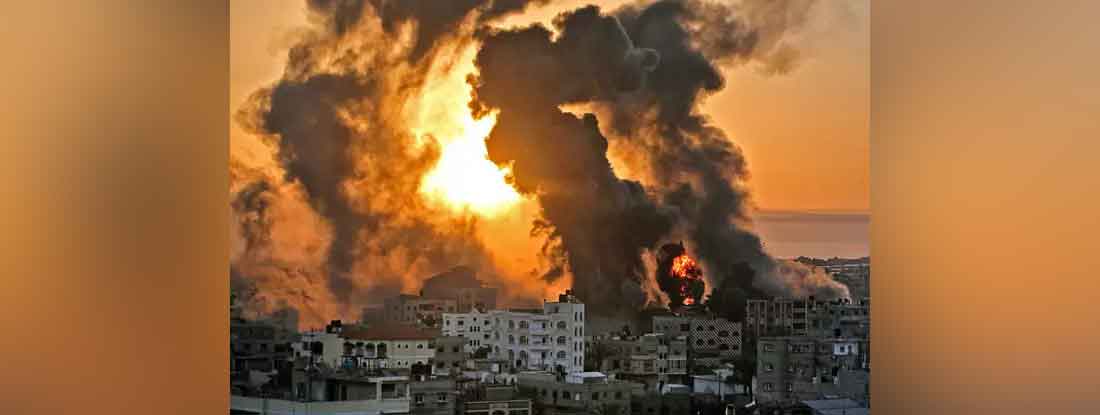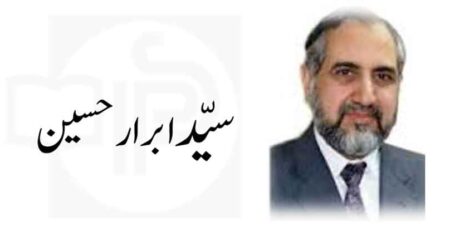اسرائیل کے مشرق وسطیٰ میں ایک طویل تنازعے میں ملوث ہونے کا امکان
سات اکتوبر 2023 کی کو حماس کے غیر متوقع حملے کے بعد، اسرائیلی وزیراعظم بنجمن نیتن یاہو نے غزہ کی پٹی میں حماس کے خلاف مکمل جنگ کا اعلان کیا۔ اس کا فوری مقصد یرغمالیوں کی بازیابی تھا، جب کہ وسیع تر مقصد حماس کی فوجی صلاحیتوں کو بے اثر کرنا تھا۔ مزید برآں، اسرائیل نے غزہ پر حماس کے کنٹرول کو کم کرنے اور سیاسی اور اسٹریٹجک اہداف کے حصول کے لیے علاقائی طاقت کے توازن کو ممکنہ طور پر تبدیل کرنے کی کوشش کی۔
اپنے مقاصد کو حاصل کرنے کے لیے، اسرائیل نے اسرائیل مصر سرحد کو سختی سے کنٹرول کرتے ہوئے فضائی حملوں اور زمینی کارروائیوں کا ایک مجموعہ استعمال کیا۔ نوے فیصد سے زیادہ انفراسٹرکچر کو منہدم کرنے کے علاوہ، سال بھر جاری رہنے والی مہم کے نتیجے میں 42,000 سے زیادہ افراد ہلاک اور 92,000 سے زیادہ فلسطینی زخمی ہوئے، جن میں زیادہ تر خواتین اور بچے تھے، جس کے اہم انسانی اور جغرافیائی سیاسی نتائج برآمد ہوئے۔
Probability of Israel engaging in a long and drawn-out conflict in Mideast
Dr. Muhammad Khurshid Khan
After Hamas’s unexpected attack on October 7, 2023, Israeli Prime Minister Benjamin Netanyahu declared a full-fledged war on Hamas in the Gaza Strip. The immediate goal was to recover the hostages, while the broader objective was to neutralize Hamas’s military capabilities. Furthermore, Israel sought to reduce Hamas’s control over Gaza and potentially shift the regional power balance to achieve political and strategic goals.
To realize its objectives, Israel utilized a combination of air strikes and ground operations, while strictly controlling the Israel-Egypt border. In addition to demolishing over ninety percent of the infrastructure, the year-long campaign resulted in the deaths of over 42,000 and injuries to more than 92,000 Palestinians, mostly women and children, having significant humanitarian and geopolitical consequences.
Key Developments Since October 7, 2023
As part of its grand strategy, Israel maintained a low tempo of operations along its northern border with Hezbollah in Lebanon. The past year’s events indicate that Hezbollah was not prepared to engage in a full-scale conflict with Israel, despite having an opportunity to strike effectively while Israel was engaged with Hamas on its western border. It is thought that Hezbollah misread Netanyahu’s intentions and remained silent, assuming that Israel would not initiate a new front with Lebanon after concluding its operations against Hamas.
Fatah, serving as the military wing of the Palestinian Liberation Organization (PLO) led by President Mahmoud Abbas, along with Hezbollah, inadvertently provided the Israel Defense Forces (IDF) with an opportunity for separate engagement. As explained above, IDF maintained a low profile along the Lebanese border, leading Hezbollah to believe that Israel had no intention of opening its northern front. On the other hand, President Abbas’s restrained strategy in the occupied West Bank facilitated the IDF’s operations.
During this period, the IDF selectively engaged targets across the region, including an attack on the Iranian embassy in Damascus, Syria, on April 1, 2024, which resulted in the death of General Mohammad Reza Zahedi, a senior commander in Iran’s Islamic Revolutionary Guard Corps (IRGC), along with 12 others. Recently, Israel also conducted air strikes against Houthis in Yemen.
Since October 2023, the Houthis have frequently targeted Western-affiliated cargo ships in the Red Sea and the Gulf of Aden. They have attacked over 100 ships and sunk two, some of them did not have any link with Israel’s war in Gaza. In the last week of September 2024, the Houthis launched what the Pentagon described as “a complex attack” using cruise missiles and drones near US Navy ships, which were either intercepted or failed, according to the Pentagon. To safeguard maritime navigation and enhance security in international waters, the US, alongside its allies, has regularly carried out airstrikes in Yemen targeting the Houthis, as well as multiple military strikes against Iranian affiliated networks’ locations in Iraq and Syria.
Eleanor Watson, a reporter for CBS News, has noted that the extensive strikes and the intermittent “whack-a-mole” tactics by the US and its allies have not stopped the Houthis from persisting in their attacks. Following the latest US strikes, a high-ranking Houthi official declared, “We will respond to escalation with escalation.” In fact, even with the deployment of a strong air force with advanced technology by the US and its allies, the Houthis remain a significant threat to American commercial vessels in the Red Sea and the Gulf of Aden.
One Year Later: Israel’s Potential Goals
While Israel has significantly weakened Hamas, it has not accomplished all of its goals. Over 100 hostages believed to be alive are reportedly still in Hamas’s custody. As I have expressed elsewhere, “Israel may have secured a ‘tactical victory’ after a year-long conflict with Hamas, utilizing cutting-edge technology alongside the US, yet, it has not succeeded strategically.” After fighting a protracted war with Israel, Hamas has conveyed a loud message to the world: without adopting the UN’s ‘two-state solution’ resolutions, lasting peace in the Middle East will remain elusive.
However, without attaining its core goals, in May 2024, the Israeli Defense Ministry suggested that Israel might use expanded military means to subdue Hezbollah. During its ground offensive, the IDF has opted to create a buffer zone about 30 km deep along the northern border with Lebanon, facilitating the return of displaced Israelis. The invasion also aims to prevent Hezbollah from attacking northern Israel, akin to Hamas’s assault on October 7, 2023. Ephrat Livni, a writer and lawyer based in New York, observes that the Israeli military invasion’s confirmed goal is to disable Hezbollah’s forces and infrastructure in southern Lebanon.
Starting in early September 2024, the IDF began a series of comprehensive airstrikes aimed at Hezbollah. These operations peaked with the death of Hassan Nasrallah, a founding member and leader of Hezbollah, during a targeted airstrike in the southern suburbs of Beirut on October 20. Netanyahu has declared that Nasrallah’s death was a primary goal. His death has led to a significant escalation in Israel’s campaign against the organization. The recent escalations and ongoing airstrikes in southern Lebanon have led to over 1,000 Lebanese casualties and the displacement of more than one million people, according to reports from Lebanese authorities.
Following extensive airstrikes, the IDF has expressed its resolve to enter southern Lebanon to dismantle Hezbollah’s military infrastructure, deploying the 98th Division alongside allied troops comprising paratrooper infantry, artillery, and elite commando units trained for behind-enemy-lines operations. The IDF has indicated it will conduct “limited, localized, and targeted ground raids” in southern Lebanon to eliminate what it terms Hezbollah’s “terrorist infrastructure”. Nonetheless, the prospect of a protracted conflict with Hezbollah remains a consideration.
Israel made similar attempts twice before. In 1982, the PLO relocated from Jordan to southern Lebanon and confronted the IDF. Following the defeat of the PLO, the IDF occupied southern Lebanon until 2000, eventually withdrawing due to various pressures including constant threats from Hezbollah. In 2006, Israel sought to neutralize Hezbollah but could not succeed. The conflict concluded on August 14, 2006, with the enactment of UN Resolution 1701 which required Israeli troops to pull back from southern Lebanon to a position in the Golan Heights below the Blue Line, and Hezbollah to retreat north of the Litani River, creating a 20-mile buffer zone. Nonetheless, the resolution was not fully enacted, as Hezbollah did not withdraw from the area.
A concise overview of the potential outcomes of the current IDF-Hezbollah conflict is essential. The IDF may face significant challenges due to several factors. Firstly, the hilly terrain of southern Lebanon, unlike the flat Gaza Strip, is not conducive to tank maneuvers, making Israeli ground forces vulnerable without close armored support, especially against Hezbollah’s battle-hardened experienced troops. Secondly, while Israeli airstrikes might cause collateral damage, Hezbollah’s main combat forces are likely to remain unscathed, sheltered by the mountainous border region and a tunnel network. Thirdly, in contrast to Hamas, which lacked defenses against the Israeli air force, Hezbollah can leverage the vast space in southern Lebanon for ground engagement with Israeli forces. Lastly, the terrain of southern Lebanon is conducive to defensive warfare. Hezbollah inflicted significant losses on the IDF during their 33-day conflict in 2006, and a similar outcome is likely to occur in the ongoing conflict, albeit with the potential for increased collateral damage due to intensified use of Israeli air power.
Possible Scenarios Leading to Long and Drawn-Out Conflict
The Mideast is on the verge of a profound and destructive conflict between two adversaries that have been in opposition for nearly 45 years. Iran, which established itself as an Islamic Republic following the Shah’s overthrow in 1979, has consistently pledged to annihilate the state of Israel, which it refers to as the “Zionist regime.” Israel accuses the IRGC of perpetuating violence throughout the Mideast via its affiliates and proxies.
Despite the IDF’s aggressive actions against Palestinians, Iran’s leadership has demonstrated patience, avoiding direct conflict with Israeli and US forces in the region. In the past year, Iran’s support for Hamas, which faces potential eradication from the Gaza Strip, has been limited to moral support, lacking tangible actions. However, on two separate occasions, the Iranian leadership faced significant pressure both domestically and from Hezbollah/Hamas. Initially, this occurred when Israel destroyed Iran’s embassy in Syria, resulting in the death of 14 individuals, including General Zahedi. Due to internal pressures, Iran felt compelled to retaliate against Israel by launching over 300 drones and a variety of missiles.
Subsequently, Iran was pressured again following the assassination of Hamas’s political chief Ismail Haniyeh in Iran and the killing of Nasrallah by the IDF in extensive air strikes in Beirut. The Iranian leadership claimed to have avenged Haniyeh and Nasrallah by firing approximately 400 ballistic missiles at targets within Israel. Various news agencies reported that the Iranian missile attack did not achieve its intended impact due to the effective Israeli/US defense system, independent sources have been unable to confirm the exact account of the damages. Nevertheless, the attack had symbolic effects, and the Iranian leadership was able to maintain public trust.
In the current situation, following Iran’s extensive missile attack on October 1, 2024, Israel is expected to respond. Netanyahu has reiterated his warnings to the Iranian government in a released video, stating, “We will go anywhere to protect our people and our nation.” He also declared that Iran would pay a ‘severe price’ for the attack. On the other hand, Iranian officials have warned Israel that any further aggression will be met with a ‘decisive response.’ The decision now lies with Israel. General Frank McKenzie, the former commander of the US Central Command, suggested that Israel’s reaction will hinge on the extent of the damage. He believes that “should the damage be substantial; a significant Israeli response can be expected.” Nonetheless, the choice of targets and the timing of any attack are decisions for Israel to make.
The expansion of the war between Israel and Hezbollah to other areas would hinge on several scenarios as explained below.
Firstly, should Israel attempt to decisively weaken Hezbollah, Iran may be compelled to intervene. This is because Hezbollah is considered a significant strategic asset for Iran, often referred to as Iran’s ‘redline.’ If Israel were to cross this ‘redline,’ the Iranian leadership might feel obliged to respond forcefully, potentially leading to an escalation of the conflict. Hence, it is dubious that the US would permit Israel to breach Iran’s ‘redline’ in the Mideast, as any escalation beyond Beirut could have far-reaching regional and global consequences. However, as previously mentioned, it is unlikely that Israel will be able to achieve its desired objectives of weakening Hezbollah beyond certain limits.
Secondly, Israel may carry out massive attacks against Iranian strategic assets like air defense system, IRGC, oil facilities, and air bases. If Iran’s air defense system is engaged and destroyed beyond a certain level, its nuclear sites would become vulnerable to Israel’s future attacks. In collaboration with the US, Israel may also select IRGC as the primary target and try to reduce its war fighting capabilities. Israel may also select Iran’s missile launch sites to neutralize them for a longer duration. By taking these initiatives, Israel could considerably weaken Iranian conventional forces. However, it is opined that Iran must have identified its limits of exercising restraints. Iran has already shown both the determination and the ability to counter any aggression that threatens its national security. Hence, Israel and the US will have to decide to what extent they can take a risk and go to exploit Iran’s weaknesses without compelling it to respond with full might.
Thirdly, in response to the Iranian missile attack on October 1, Israel’s strategy may differ from the one it employed in April 2024. Previously, Israel deliberately avoided targeting Iranian nuclear facilities, although it was suggested these could be future targets. While US President Joe Biden has advised Netanyahu against targeting Iran’s nuclear sites, such as Natanz, which is central to Iran’s nuclear program, presidential candidate Donald Trump has advised Israel to strike these locations. This is perceived as another ‘redline’ for Iran, which, “if crossed by Israel, could escalate the conflict from days to hours.”
In anticipation of such eventualities, the US has decided to bolster its military presence in the Mideast by deploying additional troops to back Israel and deter Iran from initiating a full-scale conflict.
It seems improbable that Israel would breach the Iranian ‘redline’ and strike its nuclear facilities, such an action will have enduring consequences for regional peace and security. Although Iran’s military capabilities do not match Israel’s, it can still pose significant threats to crude oil transport in the Gulf region. The IRGC Navy, which is equipped with a large flotilla of small, fast missile attack boats, could potentially destabilize the defenses of a US Navy 5th Fleet warship in a swarm attack. Moreover, by laying mines, Iran could disrupt the Strait of Hormuz, through which up to twenty percent of the world’s daily oil exports pass. Moreover, numerous US military bases along the Arabian Gulf remain susceptible to Iranian missile strikes. Iran has already warned that if attacked, it will retaliate not only against Israel but any nation it deems complicit in the aggression.
Thus, it is unlikely that the US would endorse initiatives that Israel may propose. If the US and its allies have not succeeded in deterring the Houthis from attacking oil cargoes in the Red Sea and the Gulf of Aden, it is questionable how they could afford to escalate the conflict across the entire region without severe implications for themselves and the global community at large.
It is crucial to note that engaging Iranian nuclear sites through aerial strikes would be impossible without substantial support from the US air force, including in-air refueling for a round trip exceeding 3,800 km. Utilizing missiles to target these sites would likely be ineffective, serving only to aggravate Iran and potentially hasten its nuclear enrichment efforts, possibly leading to the expedited development of a rudimentary nuclear bomb.
Furthermore, in contrast to the Gaza Strip or Lebanon, Iran’s considerable size enables it to endure pressures for a prolonged duration, potentially spanning years rather than months. During this time, Iran could potentially expedite its nuclear program and develop nuclear weapons. Over the past two decades, it is quite plausible that Iran has developed numerous alternative and decoy sites of its nuclear program that may not be well-documented by US/Israeli intelligence. Engaging multiple targets from a distance exceeding 1,924 km would not be viable.
The above discussion suggests that Israel has significantly reduced Hamas’s combat capabilities. Despite a ceasefire in Gaza, without a proper resolution to the Israel-Palestine conflict by the international community, it may take Hamas years to rebuild a force capable of challenging Israel. Moreover, Israel may risk initiating ground assaults to diminish Hezbollah’s influence and create a buffer zone, although history indicates such actions could result in a substantial loss of life and resources. Currently, many scholars believe Hezbollah’s influence in Lebanon is more connected to its military might than to any beneficial contributions. Should Israel manage to weaken Hezbollah’s fighting capability, it could then work with regional and global allies to enable UN peacekeepers, alongside the Lebanese military, to monitor the border area between Israel and Lebanon, south of the Litani River, without stirring Iranian concerns.
Dr. Muhammad Khurshid Khan SI (M) is a retired brigadier of Pakistan Army and a fellow of Stimson Center Washington D.C.











